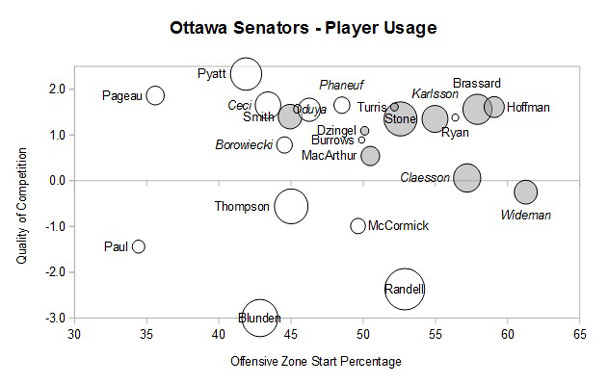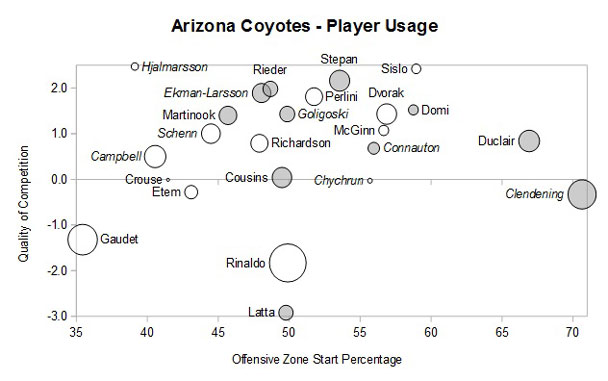As we approach the second half of the 2017-18 season and the buyers and sellers begin to stand out, offensive-minded wingers like Montreal's Alex Galchenyuk, Ottawa's Mike Hoffman and Arizona's Anthony Duclair could be the key players the league's contenders pursue in trades. What do these players bring, what are their ideal destinations and what would it take to acquire them?
In each case, we'll dig into the underlying numbers to determine just how much offensive punch each player can provide, at both even strength and on the power play.
To determine their ideal destinations, certain teams will be ruled out, including those that already average 3.00 goals per game or close to it. Those that aren't contenders this season or lack enough cap space will also be set aside. Finally, those that are already quite strong on the left side, like the Calgary Flames with Johnny Gaudreau and Matthew Tkachuk or the Carolina Hurricanes with Jeff Skinner and Sebastian Aho, will be removed from consideration.
Of the remaining handful of teams, the proposed trade will be based on which team needs a scoring jolt the most, and which teams have the right assets to spare.

Alex Galchenyuk, Montreal Canadiens
At 23, Galchenyuk still has the potential to be a team scoring leader. Things haven't gone smoothly in Montreal, where he ranks eighth with an average of 12:42 minutes per game at even strength, but he could reach his full potential with a change of scenery.
Statistically, there are two primary ways to classify Galchenyuk as a scoring-focused winger. The simplest way is by looking at his special teams ice time. Such players consistently work the power play -- 2:27 minutes per game in Galchenyuk's case -- but aren't used to kill penalties, as Galchenyuk averages just 0:01 per game of penalty killing.
The more sophisticated method is to look at a player usage chart, like the one recently published in Hockey Abstract 2017, which is based on a three-season weighted average. Scoring-focused forwards are assigned the majority of their shifts in the offensive zone, and will therefore appear on the right side of the chart, like Galchenyuk. They also tend to be close to the horizon, because they aren't tasked with taking on top opponents, as players like Max Pacioretty, Brendan Gallagher and Tomas Plekanec are.

As a result of their favorable deployment, scoring-focused players tend to have the large and shaded circles that denote good shot-based metrics. However, that is not the case with Galchenyuk, who was pretty mediocre going into this season, and is currently among the team's worst forwards in this regard.
Despite the concern that he may not contribute much defensively or in terms of shot-based metrics, Galchenyuk is still a useful addition offensively. He has averaged 1.85 points per 60 minutes at even strength since the start of 2015-16, which is right up there with Pacioretty, 1.87, and Gallagher, 1.84, for the team lead, according to the data at Corsica Hockey. With the man advantage, Galchenyuk averages 5.37 points per 60 minutes, which is the team's highest rate, well ahead of Pacioretty, 3.91, and Gallagher, 3.25.
What Montreal needs: The Canadiens rank No. 29 in goals per game this season, and will need to replace Galchenyuk's scoring. They have all the right players for greater scoring, like Gallagher, Pacioretty and Jonathan Drouin, but they need someone who can help unlock that potential. Ideally, that would be a playmaking center, so that Drouin can go back to the wing, and coach Claude Julien can stop experimenting with a secondary offensive talent like Andrew Shaw on the top line with Pacioretty.
The trade: Galchenyuk to the Columbus Blue Jackets for Alexander Wennberg, who is currently out of the lineup with a back injury.
Like Galchenyuk, Wennberg is 23, carries an annual cap hit of $4.9 million, and could use a change of scenery to unlock his full potential. The Blue Jackets need some scoring right now. They are in a tight race in the mighty Metropolitan division, have been hit with some injuries, and rank No. 26 in goals per game, and No. 31 in power-play percentage.
The emergence of Pierre-Luc Dubois has pushed Wennberg down the depth chart, and he is now battling Nick Foligno and Boone Jenner for ice time down the middle, even with Brandon Dubinsky on long-term injury reserve. In Montreal, a premier playmaker like Wennberg could help unleash Pacioretty's full scoring potential, while Galchenyuk could join Artemi Panarin to give Columbus the kind of one-two punch on the left side that could make the difference in securing a spot in the playoffs. This trade could be a win-win.

Mike Hoffman, Ottawa Senators
Ottawa's gradual fade out of playoff contention has created an opportunity for another team to acquire some valuable scoring from the left side.
Since breaking into the NHL at age 25 in 2014-15, Hoffman has averaged 2.03 points per 60 minutes, which barely trails Mark Stone for the team lead, 2.06. With the man advantage, Hoffman's scoring rate of 4.34 is ahead of Stone, 3.89, and behind only defenseman Erik Karlsson, 4.47, and Kyle Turris, 4.43, now of the Nashville Predators.
On a player usage chart, Hoffman is located on the far right side, and his presence at the top of the chart confirms that he is trusted against top opponents, and is suitable for the top scoring line. While his shot-based metrics aren't as strong as would be expected based on his favorable usage, they are still above average.

What Ottawa needs: While an upgrade in goal would be nice, what Ottawa needs most is a quality top-four defenseman. They have buried Karlsson with tough minutes, to the point where he ranks third-last in the NHL in plus/minus, at minus-22. He is followed by Cody Ceci, who would be much further down the depth chart on any other team or situation, which leaves Dion Phaneuf as the only other defenseman assigned more than 17:00 minutes per night.
The trade: Hoffman to the San Jose Sharks for Brenden Dillon.
With Paul Martin set to make his return to the lineup, Dillon will likely be returned to the third pair with rookie Joakim Ryan. Prior to his time in San Jose, Dillon was an effective, defensive-minded top-four option in Dallas, which is similar to the role played by Marc Methot in Ottawa, prior to to the latter being selected by the Vegas Golden Knights in the expansion draft and subsequently dealt to the Stars. Since Dillon carries an annual cap hit of $3.27 million through the end of 2019-20, the Senators would even save some cap space from Hoffman's $5.1875 million.
For San Jose, the appeal is to add Hoffman's scoring on the left side, where they are currently employing players like Tomas Hertl, Timo Meier and Mikkel Boedker. The Sharks are currently tied with the Anaheim Ducks for third in the Pacific division, three points up on the Calgary Flames. Even a slight lack of scoring could be enough for them to slip, and miss the playoffs for the third time in the past 20 seasons; Hoffman could help prevent that.

Anthony Duclair, Arizona Coyotes
The youngest player in this group is Duclair, 22. His current cap hit is only $1.2 million, but it expires at the end of the season, at which point the restricted free agent is likely to expect a deal in the range of Galchenyuk and Hoffman. The Coyotes may not be able or willing to manage that.
Offensively, Duclair has averaged 1.62 points per 60 minutes at even strength since arriving in Arizona for the 2015-16 season. While that's a relatively modest scoring rate, it actually ranks fourth among Coyotes in that time span, behind Radim Vrbata 1.86, now of the Florida Panthers, Martin Hanzal, 1.72, now with the Dallas Stars, and Max Domi, 1.67. Nobody else on the team is over 1.40 (minimum 1,000 minutes played).
On a player usage chart, Duclair has been highly sheltered, just like Galchenyuk. He plays more exclusively in the offensive zone, and against secondary opponents. His shot-based metrics are above average, but not necessarily as high as would be expected given his usage.

What Arizona needs: Having patched up the blue line and having settled on a mediocre but affordable goaltending tandem, the Coyotes would be looking for low-cost forward assets in exchange for Duclair. Since they rank second-last in both goals per game and goals allowed per game, they can use someone who can contribute at either end of the ice -- or ideally both.
The trade: Duclair to the Los Angeles Kings for Trevor Lewis.
The Kings have allowed the fewest goals per game, 2.32, so if they can boost their scoring from 2.95 goals per game, which is tied for No. 13, then they could lift themselves into legitimate Stanley Cup contention.
Not only could he help provide that boost, but Duclair could help Los Angeles recharge an offense that is in the older hands of players like Anze Kopitar, 30, Dustin Brown, 33, and Marian Gaborik, 35. In fact, acquiring Duclair as a replacement could allow the Kings to move Gaborik and his annual cap hit of $4.875 million elsewhere, a big help since Gaborik's deal runs through 2020-21.
As for the Coyotes, there are a number of low-cost veteran forwards from which to choose, including Jussi Jokinen, Torrey Mitchell, and the entire third line of Kyle Clifford, Nick Shore, and Lewis, which has a combined cap hit of just $4.525 million. Of these five players, Clifford and Lewis will be of greatest interest to the Coyotes, as they are each locked down until the end of the 2019-20 season.
